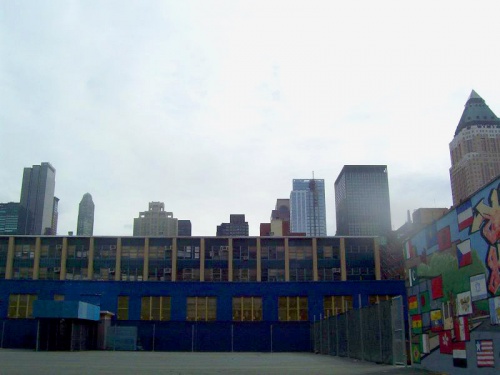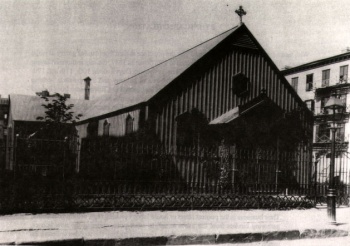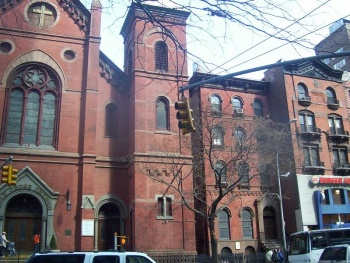The Architecture of Hell's Kitchen
From The Peopling of NYC
Low-Rise Architecture
Hell's Kitchen is known as being one of the few remaining Manhattan neighborhoods, particularly in the midtown area, to still feature primarily low-rise architecture. The above photograph, taken from 10th Avenue facing East, illustrates the contrast in the architecture style of Hell's Kitchen and surrounding neighborhoods. Buildings from 10th Avenue to 8th avenue are all primarily low, made from stone, and are either residential or home to small, local businesses. Because they are so low, these buildings cannot be seen in the photograph. East of 8th Avenue, however, starting with Broadway moving into territory we do not generally consider to be part of Hell's Kitchen, we encounter newer, taller buildings, often housing large corporations and office complexes.
Future of Hell's Kitchen Architecture
The future of Hell's Kitchen's architecture is an uncertain one. Recently, the edges of the neighborhood have given way to steel skyscrapers, and the effort to preserve the neighborhood's historic architecture is an ongoing one. On the Northeast corner, the recent replacement of the Coliseum with the Time Warner Center in Columbus Circle is evidence of the lurking changes. The same can be said for the year old Hearst Tower on Eigth Avenue and 56th. Increasingly tall architecture is also finding its way to the west edge of the neighborhood, on 11th and 12th Avenue, in the form of both large commericial and residential complexes.
The main bulk of Hell's Kitchen remains low-rise because it is protected by law. The area enclosed by 43rd and 56th street, and 8th and 10th avenue, is a "preservation area" and for a building to be built in the area, it cannot exceed 66 feet or seven stories, whichever is less. The reasoning behind preserving low-rise architecture is two-fold. One advantage of low-rise architecture is that tall buildings tend to cast a shadow over the surrounding area. The other reason is historical preservation.
This has become an issue in the last decade or so because of the gentrification that the neighborhood has undergone. The increase in wealthier families in a neighborhood tends to bring along demand for larger companies, and larger, more elaborate buildings along with them. If the trend towards gentrification continues in the neighborhood, it can be expected that the trend towards taller architecture will also continue.
The Churches
Another significant facet of Hell's Kitchen's architecture is its numerous churches. There are no less than 18 churches in the neighborhood, all with unique design and architecture.
List of Churches:
St. Michael's Church, 1857, 34th between 9th and 10th, largely Italian attendees Dutch Reformed Church, 1861, 34th 8th and 9th Collegiate Church, 1914, 305-9 West 34; demolished for New Yorker Hotel 1929, now home to Unification Church of America St. Clare's Church for Italians, 1903, 434 West 36th with a school following two years later 2nd German M.E. Church, 1913, 346-8 West 40th Mission Chapel of Atonement, 1869, 416-18-20 West 41; around 1900 merged into Zion Industrial School Holy Cross Church and school, 1854, 42nd Evangelical Lutheran Church, 424 West 44 [now New Dramatists] The 7th Associate Presbyterian Church, 1870, 432 West 44 Street, brick late Greek revival style building which later became home to the famed Actors Studio Ganes M. E. Church, 1863,461-3 W. 44 St. Luke's German Evangelical Lutheran Church, 1850, 46th between 8th and 9th Faith Chapel, 1867, 421 West 46th, became St. Clement's 2nd German Baptist Church, 46th, in 1889 became part of the assemblage by Wessell, Nickel, Gross for a new piano factory building, which in turn became an apartment cooperative in 1980. St. Albert's, 47th, primarily French and Flemish parish members Congregation Ezrath Israel The Actors Temple, 1917, 339 West 47th, the neighborhood's only Synagogue was established as the West Side Hebrew Association German Church of the Assumption of the Blessed Virgin Mary, 1859, 427 West 49; 1867 school on 50th St. James Presbyterian Church (colored) 3rd site 355-359 West 51. Irvington Hall apartments built on cleared site 1914 Sacred Heart parish, 1876, Irish, 51st between 9th and 10th Martha Memorial Church, 1886, 419-21 West 52nd Second Evangelical Church, 1869, 342 West 53rd St. Benedict the Moor, first black mission church north of Mason Dixon line, founded on Bleecker Street 1883, moved into a former Protestant church at 342 West 53rd in 1898 Amity Baptist Church, 1885, 310 West 54th St. George Theodorfus Greek Orthodox Church, 1886, 307 West 54th St. Ambrose Church, 1898, 541 West 54th. A religious order now uses this and the adjacent building as a residence for young working women.
(from http://www.nyc-architecture.com/MID/MID-HellsKitchen.htm)
back to Hell's Kitchen


